Plastic Mulch, Row Covers and Low Tunnels for Vegetable Production in Alaska
FGV-00647 View this publication in PDF form to print or download.
Plastic mulch, row covers and low tunnels are used to increase soil temperature and modify the environment around crops. Plastic mulches have been available since the early 1960s for improving and extending the vegetable production season. Various systems have been developed and adapted to commercial operations as well as small-scale vegetable gardens.
Benefits
 Many vegetables can be grown successfully using plastic mulch and row covers to extend
and enhance the field growing season. Most benefit is expected for warm-season crops
such as cucumbers, snap beans, tomatoes and sweet corn. Cole crops (cabbages) and
other vegetables well suited for the Alaska climate will also benefit, although earliness
and yield increases may not be as significant as for the warm-season crops. For example,
cabbage and broccoli grown with plastic could be harvested seven to 10 days earlier
than plantings with no plastic. For crops such as zucchini squash, harvest may start
10 to 14 days earlier with overall yields two to five times greater when grown with
plastic mulch and row covers. In trials conducted in Palmer, Alaska, the yield increased
eight times for cucumbers in a mulch and row cover system compared to the adjacent
field.
Many vegetables can be grown successfully using plastic mulch and row covers to extend
and enhance the field growing season. Most benefit is expected for warm-season crops
such as cucumbers, snap beans, tomatoes and sweet corn. Cole crops (cabbages) and
other vegetables well suited for the Alaska climate will also benefit, although earliness
and yield increases may not be as significant as for the warm-season crops. For example,
cabbage and broccoli grown with plastic could be harvested seven to 10 days earlier
than plantings with no plastic. For crops such as zucchini squash, harvest may start
10 to 14 days earlier with overall yields two to five times greater when grown with
plastic mulch and row covers. In trials conducted in Palmer, Alaska, the yield increased
eight times for cucumbers in a mulch and row cover system compared to the adjacent
field.
Besides producing earlier and increased yields, mulch and row covers have other benefits, such as more efficient use of water and fertilizer. Drip or trickle irrigation is commonly used in combination with plastic mulch. This type of watering system places the water directly at the plant to maintain uniform soil moisture around the roots. The use of plastic mulch results in less evaporation and loss of water and nutrients from the soil. Fertilizer added through the irrigation water also allows for more efficient nutrient management. In windy locations, mulch and low tunnels provide protection from soil erosion and reduce water loss from tender plants. The vegetables with plastic mulch are often cleaner, more uniform and of higher quality as they are protected from wind and direct contact with the soil.
Weed and pest management is often easier when using mulch and row covers. The number of weeds is greatly reduced in a black and wavelength-selective mulch system. Weeds growing in openings around transplants and between mulched beds tend to be more manageable. A mulch or row cover creates a physical barrier against some pests. For instance, excluding adult flies or moths that lay eggs at the base of the host plant can greatly reduce the number of root maggots. Seedlings and transplants not yet fully established are susceptible to soilborne diseases caused by Pythium and Rhizoctonia. Protection from wind and cold temperatures provides an environment that favors faster plant growth and disease tolerance.
Plastic Mulches
Several types of plastic mulch are available for covering the soil. Clear, black and wavelength-selective plastics are most commonly used. Plastic mulches of variable colors or specific characteristics are also available. These plastics may offer advantages for some crops, diversion of specific insect pests or increased disease control.
Plastic mulches generally come in rolls 3 to 5 feet wide and 2,000 to 2,400 feet in length. Garden suppliers and seed catalogs offer plastic mulch in shorter lengths, such as 100 to 1,000 feet for home gardeners. The thickness varies from 0.6 to 2.5 mil (1/1000 of an inch) depending on manufacturer and intended use.
Clear plastic has been popular for years because it effectively warms the soil. Research at Palmer, Alaska, showed that soil temperatures were 8 to 10 degrees higher under clear plastic compared to soil with no plastic mulch. The main disadvantage of clear mulch is that weeds tend to grow beneath the mulch, competing with the crop plants for water and nutrients. Weeding underneath the plastic is difficult or impossible without damaging the mulch.
Black plastic is popular because the exclusion of light prevents weeds from growing underneath it. The disadvantage is that black plastic does not warm the soil as much as clear or wavelength-selective mulches. Black plastic absorbs solar radiation and transmits the energy through conduction to the soil. A large portion of the radiant energy falling on black plastic is re-radiated or transferred to the surrounding air through convection. Clear plastic, on the other hand, allows transmission of solar radiation and energy to the soil through the greenhouse effect. For black plastic to be effective, it needs to be in contact with the soil. Air between the plastic and the soil has an isolating effect and defeats the purpose of the mulch.
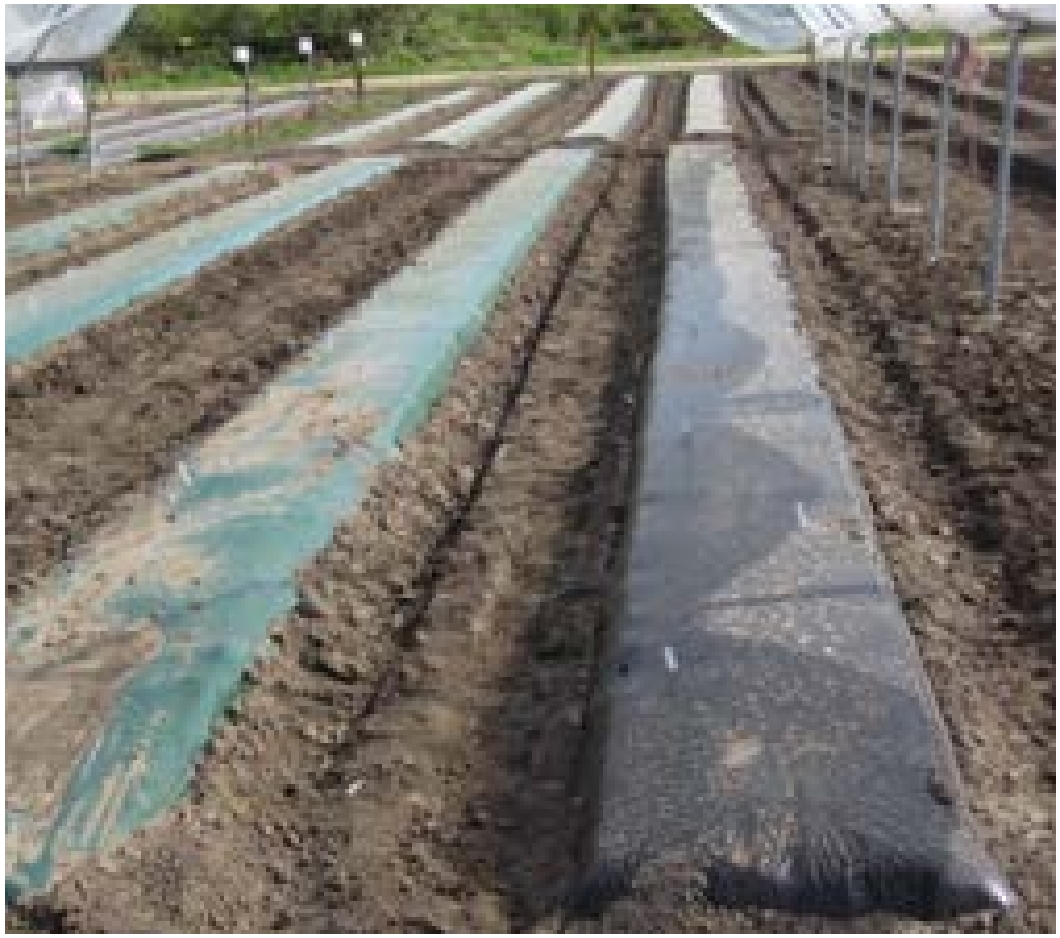
The newer wavelength-selective or IRT (infrared transmitting) mulches combine the advantages of clear and black mulches. The IRT mulch blocks the wavelengths necessary for photosynthesis and plant growth while longer infrared wavelengths pass through the mulch. The result is limited weed growth below the plastic while the soil is still being warmed.
Degradable Mulches
The removal and disposal of plastic mulch at the end of the season can be cumbersome and difficult. Opportunities to recycle the plastic are often limited in Alaska. Degradable mulches are receiving attention as an alternative to the traditional plastic mulches. Research is under way to develop plastic mulches that degrade through sunlight (photodegradable) or biological activity (biodegradable). The challenge is to have complete degradation at the end of the season without premature or partial degradation during the growing season. Paper and starch (corn, potato) products are also being evaluated for use in biodegradable mulches.
Row Covers (Low Tunnels)
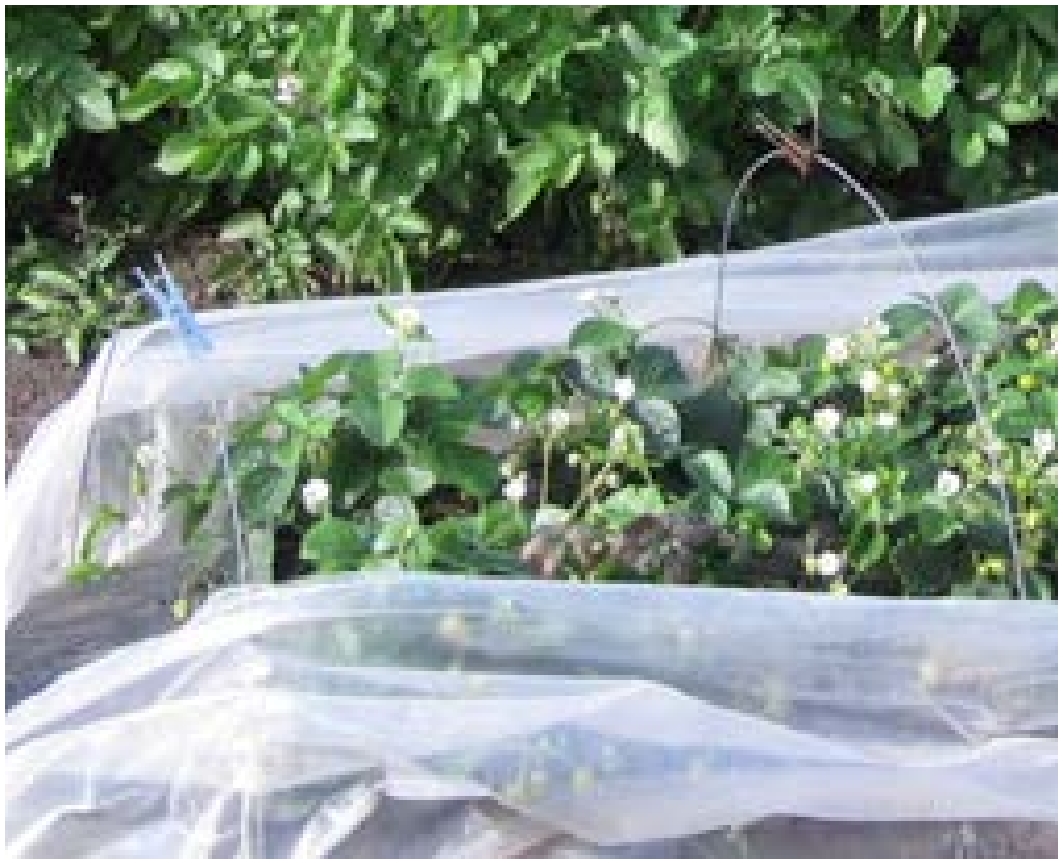
Row covers are used to increase the temperature around seedlings and transplants to facilitate establishment. Wire hoops are often used to support the cover to form a small, low tunnel over the bed and the vegetable transplants. With the use of row covers, the soil temperature can increase by 3 to 6 degrees depending on type and design approach. Row covers also provide protection from wind, cold air temperatures and pests.
Various types of materials are available and used as row covers. Transparent polyethylene plastic film is common. Sometimes the plastic film has perforations or slits to allow for moisture and air circulation. Perforated plastic has small, premade holes to provide adequate ventilation in spring and early summer. Polyethylene covers with several slits instead of small holes are also commercially available and managed similarly to the perforated material. The slits are expected to open as the plastic expands in warm weather and close during cooler temperatures. Perforated or slit polyethylene tunnels, however, tend to not provide much frost protection. In locations with high humidity, poor air circulation under or through the plastic cover may contribute to algae growth on the soil and the development of foliage diseases.
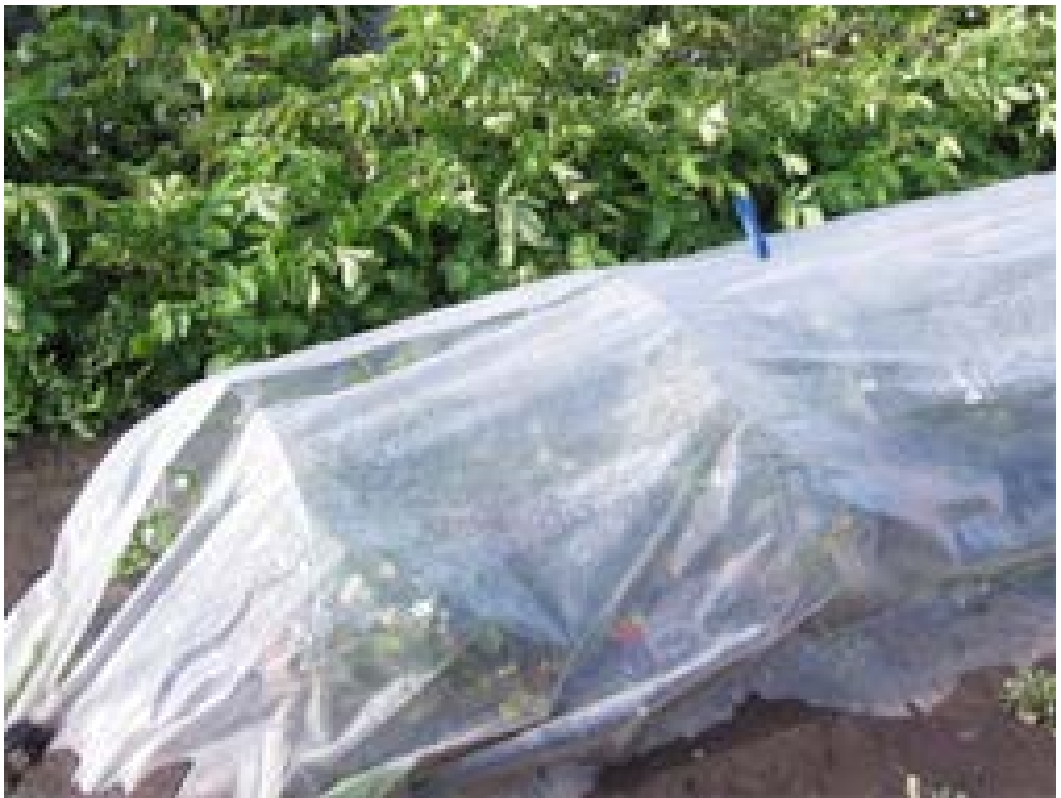
Wire hoops are used to support the row cover. The plastic row cover is stretched over the hoops and secured at the outside edges with soil to form low tunnels over the crop row. If a 4-foot-wide bed is used, the wire pieces should be 6 feet in length and spaced every 4 to 5 feet along the row. The wire should be 9-gauge or larger diameter. The wire hoops are placed into the soil to form hoops that are 16 to 20 inches high for maximum strength and wind protection. A low tunnel with no sags or folds in the plastic and the edges buried with soil on each side of the bed will provide maximum protection from wind. At the ends of the bed, the wire hoops are doubled as the row cover exerts the most pressure at these points. When the growing transplants reach the top or sides of the low tunnel, the cover is cut in sections to allow additional space for growth. As the plants continue to grow, the low tunnels are removed.
Clear polyethylene plastic without perforations or slits quickly heats up in sunlight. To allow opportunities for ventilation, a design with two pieces of plastic row cover is sometimes used. If the bed is 4 feet wide, two 3-foot-wide plastic pieces the length of the bed are prepared. The plastic pieces are secured with soil along each side of the bed. The wire hoops are installed across the bed inside the secured row cover pieces. After the bed has been planted, the two plastic pieces are pulled up and secured at the top of the hoops with clothespins or small metal spring clamps. The design allows the plastic to be opened for ventilation or closed for protection. As the growing conditions change throughout the season, the sides are raised and lowered to adjust for ventilation.
Floating Row Covers
Floating row covers are used for frost protection, exclusion of pests or to protect the crop from wind and rain damage. The material is usually a lightweight, porous, self-ventilating, woven or spun-bonded fabric. Most floating row covers permit transmission of natural light (some up to 80 percent) and offer protection from frost down to 28 degrees. Because frost protection is often one of the main purposes of floating row covers, they are sometimes called frost cloths or thermal blankets.
The floating row cover material is placed directly over several beds or rows of vegetables without wires or other support. It is kept in place with plastic or metal wire garden staples pushed into the ground. The floating row cover material can also be used as a low tunnel over vegetable transplants. There are several brands and types of floating row covers, including Reemay, a spun-bonded polyester; Agronet, an ultraviolet-stabilized polypropylene and polyamide film/net; Agribon, a spun-bonded polypropylene fabric; and Agryl P17, a spun-bonded polypropylene fabric.
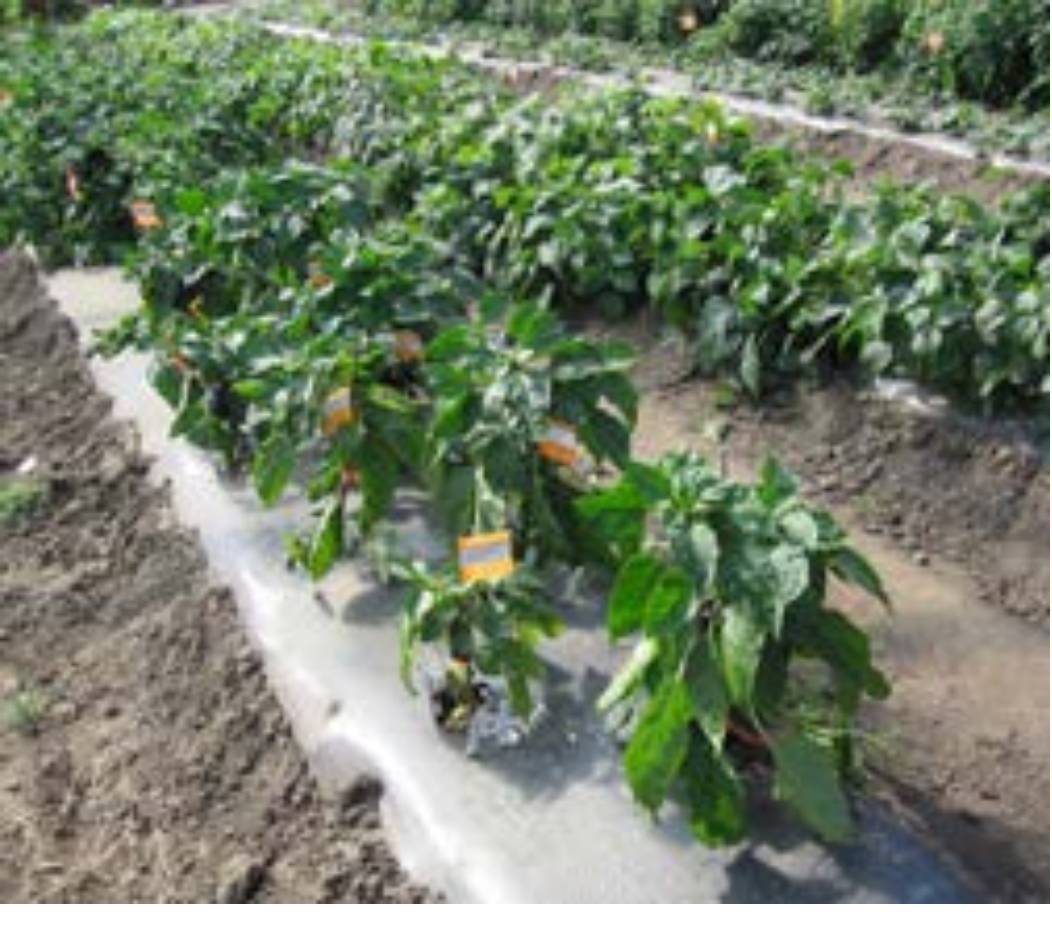
Disadvantages of floating row covers include more difficult weed control and abrasion from the wind moving the lightweight material over the crop. Some vegetables, such as young tomato and pepper plants, are more sensitive to abrasion. The leaves of summer squash or zucchini can break under a floating row cover. Pollination may also be an issue. To expose the flowers of crops that require pollination, the cloth may need to be folded back periodically.
Drip Irrigation
Drip irrigation is an essential component of a plastic mulch production system. Water use can be reduced by half compared to an overhead sprinkler system. Using a fertilizer injection system along with drip irrigation allows for more effective nutrient management.
Plastic drip tape with tiny premade holes moistens a continuous line along the bed underneath the plastic mulch. The irrigation line is made from 4- to 25-mil-thick plastic and has emitter holes every 6 to 12 inches. Most drip irrigation lines are only used for one season. However, depending on handling and the type of production system, the drip irrigation lines can be cleaned, stored and used for two or three seasons.
Water for irrigation can come from wells, streams, ponds, lakes or municipal sources. Some growers store and use water from barrels or tanks in order to temper the water. Water stored in above-ground tanks is often 12 to 16 degrees warmer than water coming directly from a well. Regardless of the source, a filter should be used to remove foreign particles in the water line.
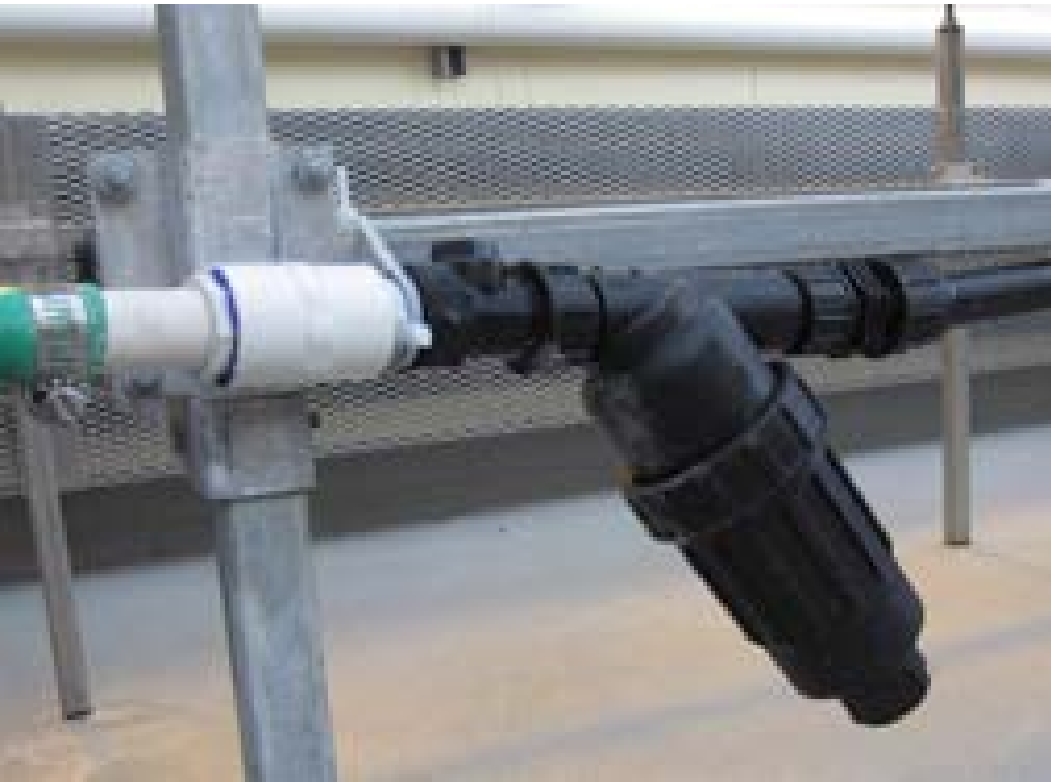
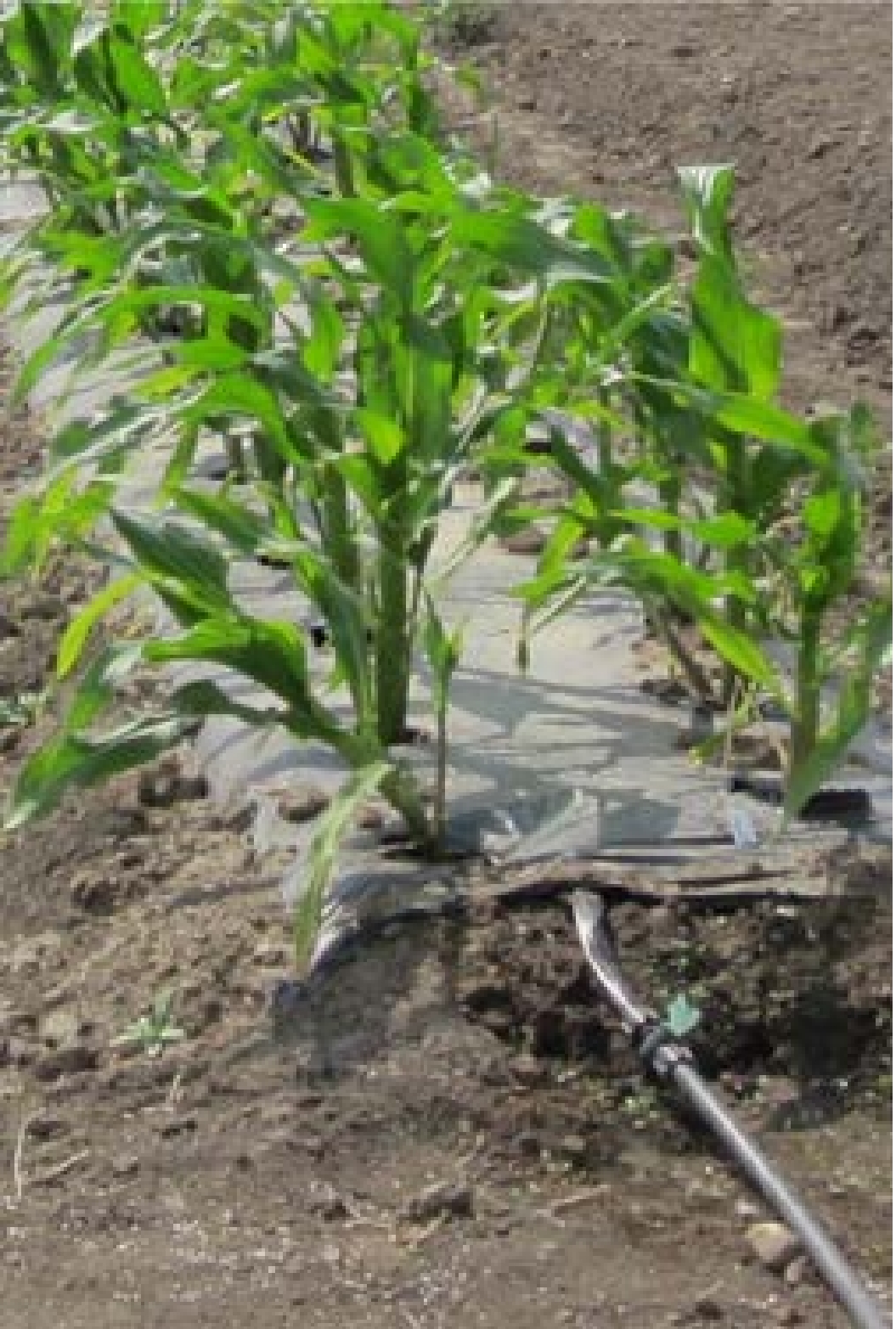
Low-pressure drip lines are designed for 4 to 12 pounds per square inch (PSI) while heavyweight lines may require 4 to 15 PSI to work properly. Since most home and farm systems use considerably higher pressure (40 to 90 PSI), pressure reduction valves are generally required. For safety reasons, a back-flow prevention valve should also be used to isolate the irrigation system. Reduction and backflow prevention valves are usually readily available, inexpensive and easy to install.
The drip irrigation line is placed under the plastic mulch as close to the transplant holes as possible. The drip line should extend beyond the plastic mulch to facilitate water hookup and shut-off. Because the soil is covered with plastic mulch, it is more difficult to determine when irrigation is needed. The soil surface may appear moist because of water condensation on the lower side of the mulch while a few inches deep, the soil is still dry. Therefore, to monitor and determine when to water, a tensiometer for measuring soil moisture is recommended.
Fertilization
Before planting, take a soil sample and have it tested to determine lime and fertilizer requirements. The amount of fertilizer to use depends on the crop grown and length of the growing season. Applying small amounts of fertilizer on a frequent basis throughout the season results in more efficient nutrient use and tends to reduce potential problems with soluble salt injuries. The fertilizer concentration is normally increased as the season progresses and crop demand increases. The goal is to tailor the fertilizer to the needs of each crop for maximum efficiency while minimizing loss of nutrients through leaching.
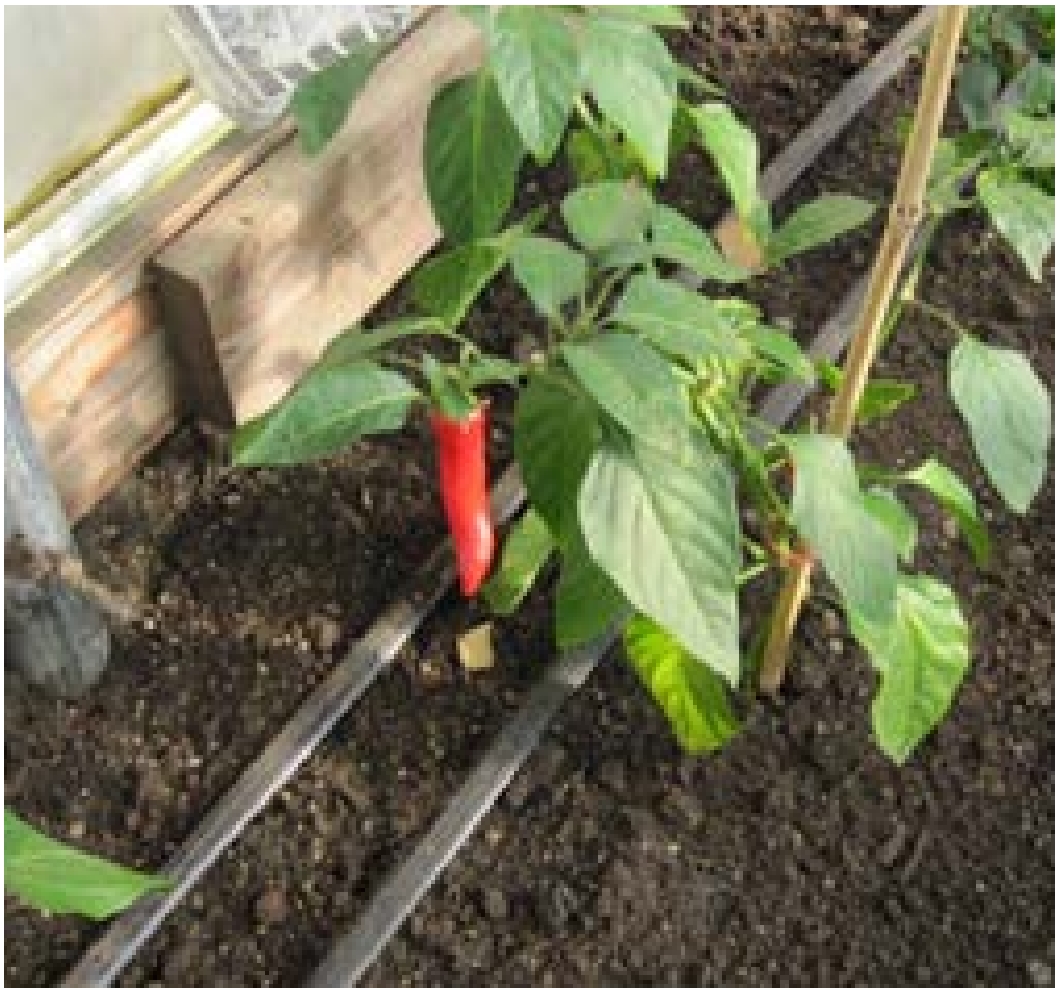
Approximately 35 percent of the total nitrogen and potassium and all of the phosphorous may be applied prior to laying the mulch if fertilizer will also be provided through the drip irrigation (fertigation). If fertigation is not planned, all fertilizer should be applied before the mulch is installed. The plants will have fast initial growth with a starter solution high in phosphorous. A soluble fertilizer with an analysis of 10-52-17 or 10-20-10 is a good choice.
For information on soil sampling and choosing a soil testing laboratory, see UAF Cooperative Extension Service publications FGV-00044, “Soil Sampling,” and FGV-00045, “Factors to Consider in Selecting a Soil Testing Laboratory.”
Bed Preparation
Proper preparation of the beds is essential before laying plastic mulch and irrigation lines. A raised bed results in earlier soil warming in the spring and facilitates water run off during rainfall. The soil needs to be sufficiently packed for the bed to maintain structure and shape. This will allow the plastic to come in close contact with the soil. A loose fit with air in between the plastic and the soil provides insulation and prevents soil warming. Excessively dry or wet soil does not work well for raised beds in a plastic mulch system. Dry soil tends to settle and the bed loses its shape. An overly wet soil does not provide good contact with the plastic. An adequately moist soil will support seed germination and transplant growth early in the season.
Beds can be prepared by hand or by using various types of tools and equipment. Implements specifically designed for making beds are available for garden tractors. Some commercial bed makers prepare and shape the beds while the drip tape and mulch are installed by hand afterwards. In addition to making the beds, more advanced bed makers also lay drip tape and mulch in one operation.
Beds can be constructed in a variety of widths and heights. For vegetable production, beds that are 24 to 30 inches wide and 4 to 6 inches high with gently sloping sides work well. The beds should be on 4- to 6-foot centers depending on the crop management approach. Enough spacing between vegetable beds is needed to allow the plastic mulch to be secured on each side and for foot traffic and the use of equipment for weed control.
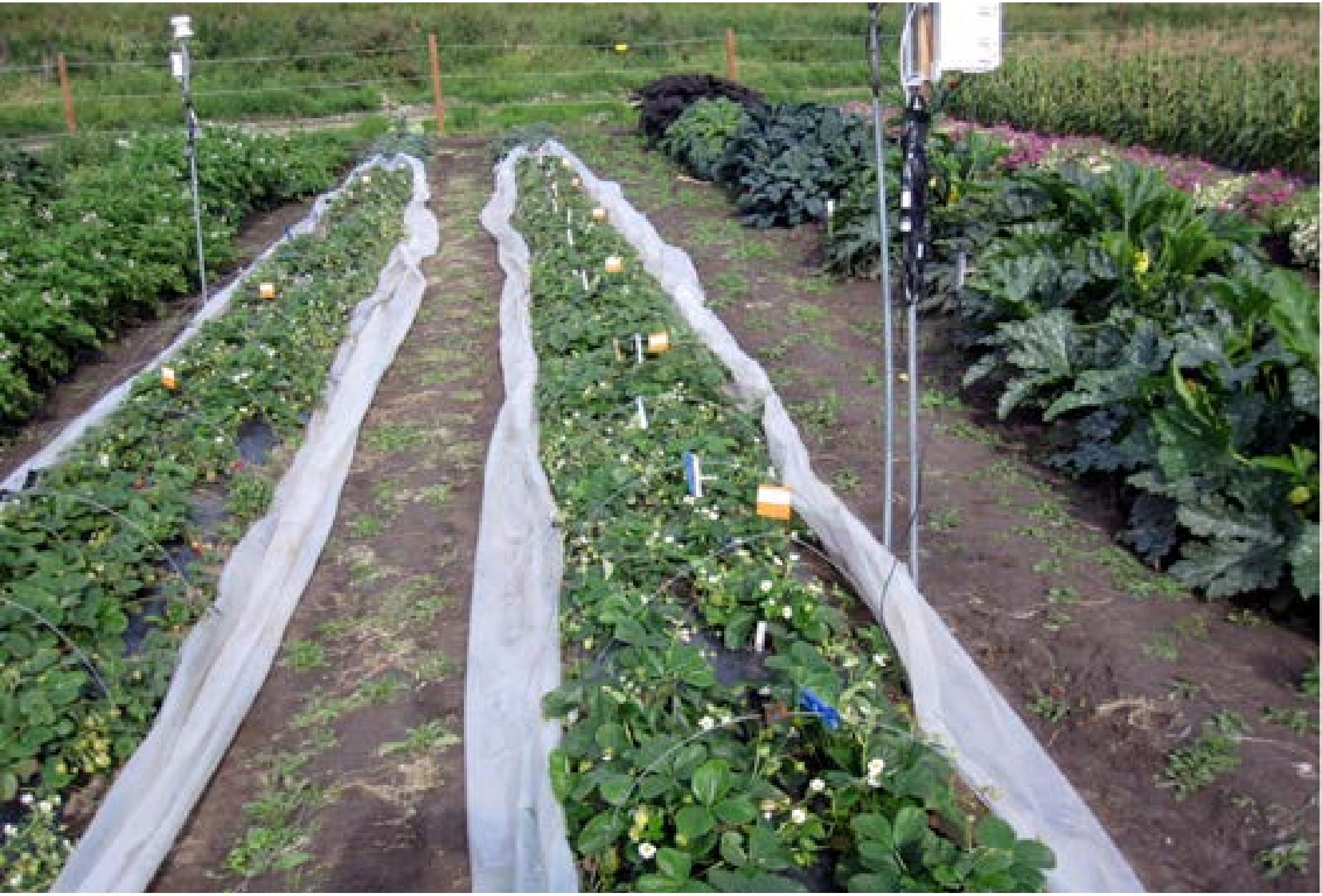
Planting Methods
Vegetables can be transplanted or direct seeded. Whenever possible, transplants should be used in Alaska for earlier production and increased yield. Transplanting can be done by hand or by a mechanical pot or punch transplanter. A bulb planter works well when planting by hand. A 3- or 4-inch hole is cut through the plastic mulch and into the soil for planting the transplant.
Direct Seeding
Seeding can be done directly through the mulch, but planting the seeds before applying the mulch is easier. The mulch is slit after the seeds germinate to allow the plants to emerge through the mulch. If this method is used, the row covers will have to be of the open top design and clipped with clothespins. Otherwise, there is no access to the plants through the low tunnel. An alternative is to direct seed using a mulch with premade slits for the germinated seeds to grow through. The row cover of perforated or other types of plastic can then be installed along with the mulch after seeding.
Crop Management
For peak quality, many vegetables will need to be harvested twice a week depending on the growing conditions. At the end of the growing season, the plants, wire hoops and the plastic mulch should be removed. Irrigation and supply lines, drip line connectors, fertilizer injector systems and water filters need to be cleaned and stored. Non-degradable plastic should not be tilled in, as small plastic pieces will remain in the soil. The breakdown is very slow in cold Alaska soils, and long dark winters prevent photodegradation.
Keep Records
Written records and notes on soil preparation, plastic and irrigation installation, seeding and planting times, production techniques, crop development and maturity, harvesting intervals, lessons learned and areas for improvement will be valuable in planning for the next growing season. The use of plastic mulch and row covers in crop production is a developing area with new products and materials continuously becoming available and marketed. Staying informed and educated about the advantages of using plastic mulch, row covers and low tunnels to produce vegetables in Alaska is important for producing the best crop possible.
HGA-01268, “Plastic Mulch and Row Covers for Vegetable Production in Alaska,” is available on YouTube. It covers benefits, installation and use of plastic mulch and row covers.
To simplify information, trade names of products have been used. No endorsement of named products by the University of Alaska Fairbanks Cooperative Extension Service is intended, nor is criticism implied of similar products that are not mentioned.
Meriam Karlsson, Professor of Horticulture, Agricultural and Forestry Experiment Station. Originally written by Jerry Purser, former Agriculture Development Agent, UAF Cooperative Extension Service.
Reviewed October 2021
